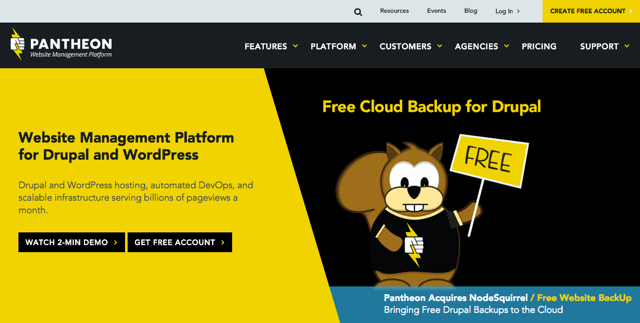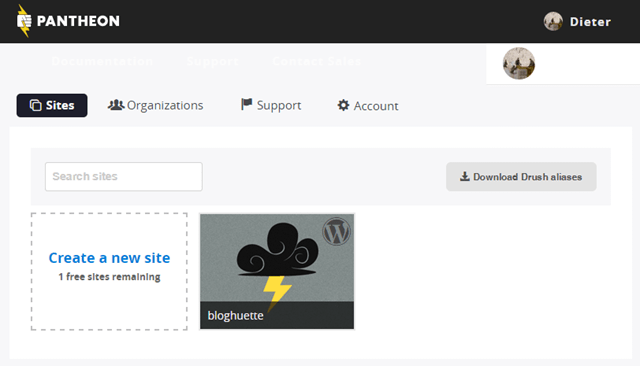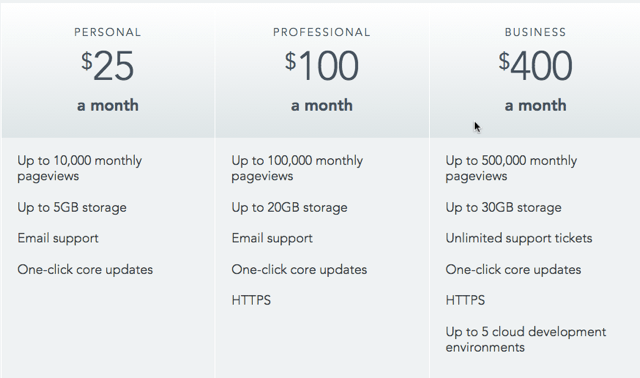Pantheon: The Next Dimension of WordPress and Drupal Hosting and Management

As a freelancer or even more so as an agency in the field of web design and development you have to cope with a plethora of challenges. Pantheon cannot take all the burdens off your shoulder but substantially relieve the pains of your everyday life. With Pantheon, you need not worry about the technical part of a website development project anymore. The service not only provides simple hosting but offers sophisticated development support on top. As a designer/developer, alone or as part of a team, Pantheon is your one-stop solution for designing, coding and hosting any number of client projects. Never heard of them? You should definitely check Pantheon out...
 If you know what hosting is, if you know what a version control system is, if you are used to working in different environments besides the live server - then Pantheon is for you as it integrates all these aspects into one smooth and seamless work-flow. With their latest product Pantheon for Agencies, it is even possible to have multiple developers working on different tasks on one and the same project while having Pantheon take care of proper versioning and merging work states.
If you know what hosting is, if you know what a version control system is, if you are used to working in different environments besides the live server - then Pantheon is for you as it integrates all these aspects into one smooth and seamless work-flow. With their latest product Pantheon for Agencies, it is even possible to have multiple developers working on different tasks on one and the same project while having Pantheon take care of proper versioning and merging work states.

 Should these offerings not fit your needs get in touch with Pantheon and they will try to make ends meet.
Should these offerings not fit your needs get in touch with Pantheon and they will try to make ends meet.
What is Pantheon?
Let's start by saying what Pantheon is not. Pantheon is not one of those homepage builders, website creators, page generators or an online web design software as a service. So don't mistake them as a competitor of Wix, Webydo or whatever first springs to your mind. While all the before mentioned services focus on the design aspect of the job, Pantheon builds a solid foundation for developing and designing regardless of the tools you use to do it. Pantheon, located in San Francisco, California, started as a technical hosting provider for Drupal but has since extended its solution to cover WordPress as well. With these two products supported you can build everything from the smallest corporate blog to the largest brand website imaginable. Just to avoid another misunderstanding; Pantheon is not kind of an assistant guiding you through the process. Instead, Pantheon supports people who know what they do. This service is not for the son of the colleague of the aunt of your brother who knows how to do a website. This service is for professionals only. If you know what hosting is, if you know what a version control system is, if you are used to working in different environments besides the live server - then Pantheon is for you as it integrates all these aspects into one smooth and seamless work-flow. With their latest product Pantheon for Agencies, it is even possible to have multiple developers working on different tasks on one and the same project while having Pantheon take care of proper versioning and merging work states.
If you know what hosting is, if you know what a version control system is, if you are used to working in different environments besides the live server - then Pantheon is for you as it integrates all these aspects into one smooth and seamless work-flow. With their latest product Pantheon for Agencies, it is even possible to have multiple developers working on different tasks on one and the same project while having Pantheon take care of proper versioning and merging work states.
Pantheon as a Host
Let's start with the most obvious thing Pantheon does, a thing that anyone maintaining a web site will immediately understand. Pantheon hosts your website. Simple as that. You don't need to buy any hosting plan, web server or shared web-space to upload your websites to. Instead, you let Pantheon take care of that. The benefits are obvious as soon as you don't maintain one single website with no wish of ever expanding to at least two. As a freelancer or agency, you juggle with a multitude of different clients and their projects. Having these projects hosted individually by different providers leads to a fragmented infrastructure and a load of effort for keeping on track who is hosted where and properly administering credentials to any number of back-ends. In Pantheon starting a new website project is just one click away. Setting up the domain is easy, and the process is consistent with all the projects you will ever manage.
Designers and Developers in the Pre-Pantheon Era
Now we have a place for the website data on the web, but being true to oneself, having the files of your client's website hosted properly does not take you anywhere. You only have the files stored on some web server in the cloud. This doesn't help when it comes down to development or design. Most designers and developers I know have a local test-server installed. This is vital as making chances directly on the live website might work for the Pizza guy around the corner but not for larger than very small projects. And a local test-server doesn't kick it when you are not the only developer but part of a larger distributed team. Even with this local test-server there is enough effort left. You develop on your local machine and test with Mampp, Xampp or whatever basis underlies your work-flow. When everything seems to run fine, you upload the files to the place in the cloud where you most probably will have created another instance of the project in the form of a sub-domain such aspreview.clientproject.com to be able to show your progress to the client before putting it live.
Did the client approve? Well, then let's upload everything to the live server again. That's the designer's fate.
When it comes to development, even individual freelancers have turned to version control systems. Gits are common and make a developer's life much easier even if there is no other contributor to the project. Sites like GitHub, Source Forge, and others support developers in this regard and have become the established way to do development in our time and age.
Working with one of these solutions is fine and well but still leaves you to care for merges, updates and all the other kerfuffle yourself. Once you figured all that out, upload the stuff to where you need to place it.
Pantheon's Designer and Developer Support
Now let Pantheon enter the stage (applause rises). Pantheon does not take any element away when it comes down to the work itself. As I already mentioned, it will not help a designer who cannot design come up with a great layout nor will it help a developer who cannot code become America's Next Top Coder. You will still have to have all the necessary skills to do your job yourself. You still need to code by yourself ;-) What Pantheon does is speed up the work-flow itself by removing avoidable disruptions. Above I talked a lot about having to manage credentials, get accustomed to multiple admin back-ends. Forget that. Pantheon hosts all your sites and you only learn one consistent way of getting new websites up easily. I also talked a lot about installing a local machine for design and development, then creating a preview for the customer most likely in the form of a sub-domain of the live domain, most likely password-protected and not indexed. Forget that. Pantheon provides you with all the necessary environments for development, previewing and going live from one single back-end. The only thing that you will not get rid of is the uploading of files to the platform. But hey, where should it grab them from? Have a WordPress core installation with the needed plugins and more already integrated and as such tailored to the needs of your target industry? Pantheon can let you deploy this tailor-made instance to any new project with a simple click. Developers can connect their gits to Pantheon and have the service maintain them. No more separate version control systems are needed, everything is controlled from within Pantheon directly. Did I name Pantheon a one-stop shop? Seems I was right...Pantheon's Server Infrastructure
If I already convinced you to try Pantheon out for yourself I can relax and lean back, as this was my only intention. Developers are a diverse population and not everybody will like the completeness of the service with the conventions involved. But, in any case, do yourself a favor and check this service out. This can be done completely free of charge and with all the features provided. The only thing you cannot do in trial mode is go live with your project. Take two minutes to watch this video. It will provide with a thorough first impression of what's in store for you: https://www.youtube.com/watch?v=KpGTDeqwgX4 Hosting a website is about performance and reliability, but most of all it's a matter of trust. There are companies out there who don't care much for technical infrastructure although their main business is to provide technical infrastructure. Sounds crazy? It actually is. With large cloud service providers such as Amazon's EC2, Microsoft's Azure and some others almost anybody can build a large scale web services, even for services. All in all the reliability of the bigger competitors in the field is more or less in order but complete failures and down-times have already happened frequently and always will. The problem for the client is obvious. But the problem for the service provider relying on other people's clouds is none less obvious. All he can do is ... nothing. Pantheon decided to not take that risk and build its own server infrastructure. This doesn't mean they could never experience outages of any kind. But at least they can do something about it as they have their hands on each and every physical machine. Moreover, they can minimize risks beforehand whereas on a cloud provider you never know whose buggy software brings all the others down. If you are into all the details of how the server architecture is designed and why, head over to Pantheon's elaborate description of it.Pantheon's Pricing
Pantheon's pricing is not for the impulse buyer. They provide a valuable platform and they know it. The bread and butter prices are as follows: Should these offerings not fit your needs get in touch with Pantheon and they will try to make ends meet.
Should these offerings not fit your needs get in touch with Pantheon and they will try to make ends meet.
Conclusion
Pantheon offers a different approach to website projects based on Drupal and WordPress. Designers and developers alike are invited to save loads of time formerly spent on tasks now automagically done by Pantheon. If you like to focus on the creative side of work and less on the technical details of how to get and keep a website running on the web, Pantheon is definitely worth checking out. Reclaim your creativity!Photo by Souvik Banerjee on Unsplash
